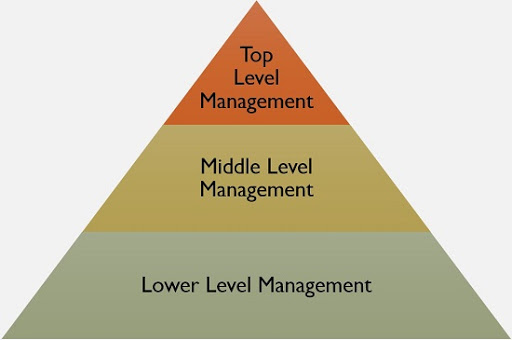Managerial Hierarchy / Levels of Management & Its Function
The term levels of management refer to the arrangement of managerial positions in an organization. The concept of division of managerial hierarchy into different levels was brought into practice to divide the authority and responsibility into various levels. It is essential to perform organizational jobs systematically. For this, management hierarchy is divided into different levels and in each level a manages or head is appointed. They are responsible for all the activities of the department concerned or section for which they are appointed.
WHAT ARE THE THREE LEVELS OF MANAGEMENT?
The common managerial hierarchies practiced in different organizations are as follows:
- Top Level Management
- Middle Level Management
- Lower Level Management

Top Level Management
Top Level Management is the highest level. This is the highest level of the managerial hierarchy and is also known as brain management. The top-level management derives its power directly from the owners of the enterprise. In the corporate enterprise, top-level management is constituted with a management committee elected directly from shareholders as members of the board of directors. Besides, this level also includes a chief executive like a chairman, president, managing director or general manager.
Top level managers are responsible for the performance of the entire organization. They coordinate among different departments and units of an organization performing the complex and varied nature of jobs. They are working long hours and spending much of their time in meetings and decision making.
Functions of Top Level Management
- Define the overall objectives of the organization.
- To prepare strategic plans and policies of the organization.
- To direct, coordinate and lead all subordinates.
- To exercise overall control of all members of the organization.
- To represent the organization to the outside world.
- To appoint departmental managers and guide them to do their work.
- To evaluate and review the performance of all departments and take the necessary steps to achieve organizational objectives.
- To set up an organizational structure to complete the work efficiently and systematically.
Middle Level Management
Middle Level Management consists of functional heads of different departments and is responsible for preparing and implementing departmental plans. Middle-level management is the largest group of managers in most organizations. It is known as the backbone of an organization. This level of management consists of departmental heads like human resource manager, production manager, marketing manager, finance manager, procurement manager, and similar other positions.
In some big organizations, this level of management may have two layers— senior and junior middle-level management. Head of the department comes under the senior level whereas branch heads are considered as under junior level management. The top-level management delegates a major part of its authority and responsibility to this level. This level plays the role of mediator between the top and first-line management. The managers of this level have to report about the accomplishment of work to the top level and give instructions to the lower level.
Functions of Middle Level Management
- To play the role of mediator between top-level and first-line management.
- To implement plans and policies laid down by the top-level management
- To divide work among subordinates and maintain coordination among them.
- To delegate authority and responsibility to the first-line management.
- To make provisions of training, workshop, seminar, and other activities.
- To submit progress reports and recommend valuable suggestions to top-level management.
- To prepare departmental plans and strategies based on guidance and information from top-level.
Lower Level Management
This is the lowest level. This level is known as the first-line or operating level of management. It is directly involved in the actual operation of production, marketing, financing, accounting, etc. This level consists of supervisors, foremen, sales officers, accounts officers, superintendents, and other operational heads. They are responsible for the implementation of plans and strategies developed by the middle-level management. They have a direct relation with the employees who are involved in operations. This level is directly responsible for the completion of works in time to achieve planned objectives.
Functions of Lower Level Management
- To manage resources
- To assign responsibilities and duties to the employees.
- To provide necessary instructions and guidance to subordinates.
- To maintain a dose and harmonious relationship among all the employees.
- To submit a progress report to the middle-level management.
- To operate and create a better environment for work.
- To perform intermediary functions between middle-level management and operating level management.
So, the above-mentioned were the three levels of management. You can also download the 3 Levels of Management PDF from here.
Also Read:
- Introduction to Management: Concept and Definition of Management
- Characteristics of Management – Principles of Management
- 14 Principles of Management By Henri Fayol
- 5 Process and Functions of Management
Reference:
- Pouydal, Santosh Raj – Principles of Management, Edition 2017, Ashmita Books Publishers and Distributors – Kathmandu
- Pradhan, Gopal Man – Principles of Management, Edition 2017, Ashmita Books Publishers and Distributors – Kathmandu
- Bhandari, Kedar Prasad – Principles of Management, Edition 2017, Ashmita Books Publishers and Distributors – Kathmandu
